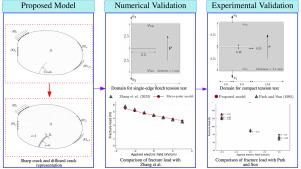A micropolar phase-field model for size-dependent electro-mechanical fracture
IF 7.1
1区 工程技术
Q1 ENGINEERING, MECHANICAL
International Journal of Mechanical Sciences
Pub Date : 2024-11-05
DOI:10.1016/j.ijmecsci.2024.109805
引用次数: 0
Abstract
This article proposes a micropolar phase-field model for size-dependent brittle fracture in solids under electro-mechanical loading conditions. Considering displacement, micro-rotation, electric potential, and phase-field variable as the kinematic descriptors and employing the virtual power principle, we derive a set of coupled governing partial differential equations (PDEs) for size-dependent solids. Invoking the first and second laws of thermodynamics, we determine the constitutive relations for the thermodynamic fluxes. Carrying out the finite element implementation of the derived governing PDEs using the open-source Gridap package in Julia, we demonstrate the efficacy of the proposed phase-field model through a few representative numerical examples. Especially the importance of the proposed model in incorporating the effect of relative rotation, i.e., the difference between macro- and micro-rotation, on the response of solids under electro-mechanical loading is shown that may not be possible with the existing non-local models such as strain-gradient or couple-stress approaches. To capture the experimentally observed size effects in solids under electro-mechanical loading, the proposed model does not demand higher-order continuity of the field variables, unlike a typically used strain gradient model. To demonstrate the efficacy of the proposed model, we have compared our results against demanding experimental and numerical benchmark results available in the literature. We provide a parametric study to unravel the effect of different micropolar material parameters on the electro-mechanical response of a brittle solid. Interestingly, the proposed micropolar model is less sensitive to the phase-field length scale than the conventional non-polar phase-field models.

尺寸依赖性机电断裂的微相场模型
本文提出了一种微极性相场模型,用于研究在电动机械加载条件下与尺寸有关的固体脆性断裂。考虑到位移、微旋转、电动势和相场变量作为运动学描述符,并利用虚拟功率原理,我们推导出了一组尺寸相关固体的耦合控制偏微分方程(PDEs)。援引热力学第一和第二定律,我们确定了热力学通量的构成关系。我们使用 Julia 中的开源 Gridap 软件包对推导出的支配 PDEs 进行了有限元实现,并通过几个有代表性的数值示例证明了所提出的相场模型的有效性。特别是在结合相对旋转(即宏观和微观旋转之间的差异)对固体在电动机械加载下的响应的影响方面,我们展示了所提出模型的重要性,而现有的非局部模型(如应变梯度法或耦合应力法)可能无法做到这一点。为了捕捉实验观察到的固体在电动机械加载下的尺寸效应,与通常使用的应变梯度模型不同,所提出的模型不要求场变量的高阶连续性。为了证明所提模型的有效性,我们将我们的结果与文献中要求苛刻的实验和数值基准结果进行了比较。我们提供了一项参数研究,以揭示不同的微极材料参数对脆性固体的电动机械响应的影响。有趣的是,与传统的非极性相场模型相比,所提出的微极性模型对相场长度尺度的敏感性较低。
本文章由计算机程序翻译,如有差异,请以英文原文为准。
求助全文
约1分钟内获得全文
求助全文
来源期刊

International Journal of Mechanical Sciences
工程技术-工程:机械
CiteScore
12.80
自引率
17.80%
发文量
769
审稿时长
19 days
期刊介绍:
The International Journal of Mechanical Sciences (IJMS) serves as a global platform for the publication and dissemination of original research that contributes to a deeper scientific understanding of the fundamental disciplines within mechanical, civil, and material engineering.
The primary focus of IJMS is to showcase innovative and ground-breaking work that utilizes analytical and computational modeling techniques, such as Finite Element Method (FEM), Boundary Element Method (BEM), and mesh-free methods, among others. These modeling methods are applied to diverse fields including rigid-body mechanics (e.g., dynamics, vibration, stability), structural mechanics, metal forming, advanced materials (e.g., metals, composites, cellular, smart) behavior and applications, impact mechanics, strain localization, and other nonlinear effects (e.g., large deflections, plasticity, fracture).
Additionally, IJMS covers the realms of fluid mechanics (both external and internal flows), tribology, thermodynamics, and materials processing. These subjects collectively form the core of the journal's content.
In summary, IJMS provides a prestigious platform for researchers to present their original contributions, shedding light on analytical and computational modeling methods in various areas of mechanical engineering, as well as exploring the behavior and application of advanced materials, fluid mechanics, thermodynamics, and materials processing.
 求助内容:
求助内容: 应助结果提醒方式:
应助结果提醒方式:


